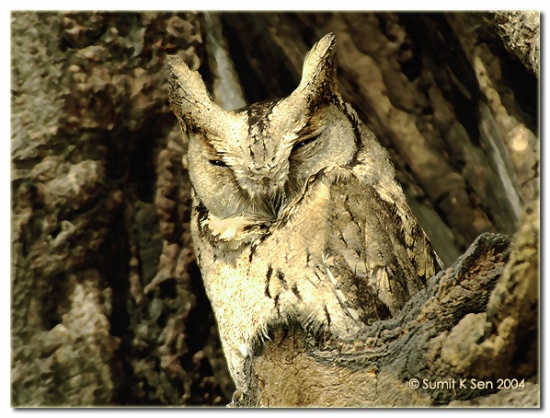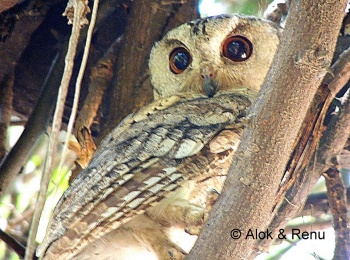- Otus bakkamoena
Identification
23-25cm. Small head tufts, or ears. The upperparts are grey or brown, with faint buff spotting. The underparts are buff with fine darker streaking.
The facial disc is whitish or buff, and the eyes are orange or brown. There is a buff neckband. Sexes are similar. The flight is deeply undulating.
Distribution
Pakistan, northern India and the Himalayas east to south China. Also in southeast Iran.
Taxonomy
Collared Scops Owl, Otus lettia, is sometimes considered a subspecies of the species presented here, Indian Scops Owl. In those publications where the taxon lettia is included in Otus bakkamoena, the common name Collared Scops Owl is used for the combined species.
Subspecies
As currently defined, Indian Scops Owl includes four subspecies1:
- O. b. deserticolor:
- O. b. gangeticus:
- O. b. marathae:
- Central India
- O. b. bakkamoena:
Habitat
Forests and well-wooded areas.
Behaviour
It nests in a hole in a tree, laying 3-5 eggs.
Nocturnal.
Diet is mainly insects.
References
- Clements, J. F., T. S. Schulenberg, M. J. Iliff, D. Roberson, T. A. Fredericks, B. L. Sullivan, and C. L. Wood. 2017. The eBird/Clements checklist of birds of the world: v2017, with updates to August 2017. Downloaded from http://www.birds.cornell.edu/clementschecklist/download/
Recommended Citation
- BirdForum Opus contributors. (2025) Indian Scops Owl. In: BirdForum, the forum for wild birds and birding. Retrieved 5 February 2025 from https://www.birdforum.net/opus/Indian_Scops_Owl
External Links
GSearch checked for 2020 platform.1





